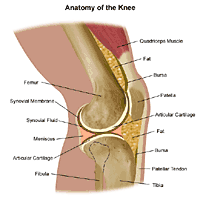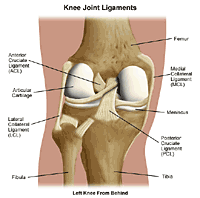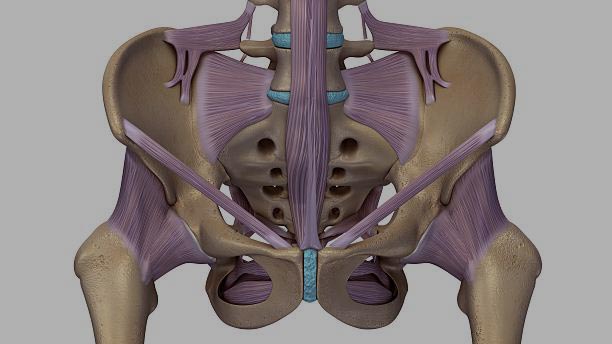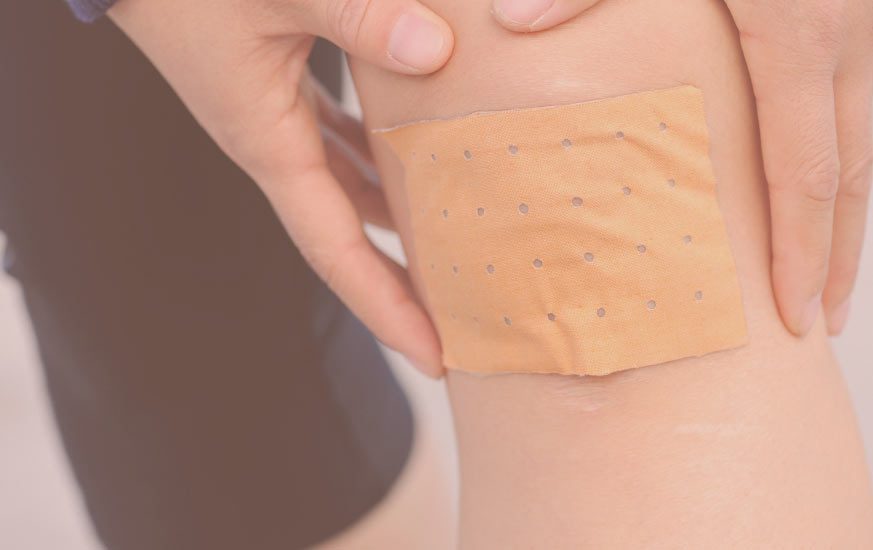Rebuilding Worn Knees
Damage to the ACL (anterior cruciate ligament), the most common injury, occurs in athletes who play basketball, football, tennis or soccer, or in skiers. An MRI helps reveal the extent of the damage.
Ligament Reconstruction for a Return to Normal
Knee reconstruction– either total or partial– is actually a tissue graft. The orthopedic surgeon takes healthy tendon tissue from the patient’s own hamstring muscle or knee, and uses it to replace a damaged ligament. In some cases, donor tissue may be used.
 There are four ligaments that support the knee, allowing for weight-bearing strength and flexibility.
There are four ligaments that support the knee, allowing for weight-bearing strength and flexibility.
- The posterior cruciate ligament (PCL) and anterior cruciate ligament (ACL) are located inside the knee joint. They control our back-and-forth movement.
- The medial collateral ligament (MLC) is on the side of the knee towards the body;
- the lateral collateral ligament (LCL) is on the outside of the knee. The collateral ligaments control sideways motion. They are the ‘brakes’ that protect us from harmful movements.
Ligaments connect one bone to another. The ACL connects the femur (thigh bone) with the tibia (shin bone). A torn ACL is the most common knee injury.
This ligament was designed to handle forward motion and rotation of the tibia.
ACL injuries are most common in athletes between the ages of 15 and 45– the ages when people are most active.
 Other Knee Ligament Injuries
Other Knee Ligament Injuries
We also see injuries to the PCL, the ligament that controls backward movement of the tibia; the MCL, which supports the inner part of the knee; and the LCL, which stabilizes the outer knee.
ACL injuries are often caused by a specific event. The patient is usually in pain, and has limited function or mobility. He or she may want to return to their sports or favorite activity as soon as possible.
Knee Ligament Reconstruction Recovery
Generally speaking, recovery time for knee constructive surgery falls into phases. The first one to three weeks are focused on decreasing the swelling by elevating and icing the leg, and exercises on a stationary bicycle.
- From two to six weeks post-surgery, the patient is given exercises to improve range of motion and strength.
- From six weeks to about four months, the patient can begin jogging. After six months, the patient may return to sports activities.
Surgical techniques for repairing damaged knees have made great advances over the past few decades, and many elite athletes recover and go on to excel after suffering an injury that, a few decades ago, would have ended their career.
To find out more about knee ligament reconstruction read through the National Institutes of Health (NIH) website or contact our Pembroke Pines Orthopedics clinic to speak with one of our Miami orthopedic surgeons or to schedule an appointment.
Before Knee Ligament Reconstruction Procedure
During the procedure
After Knee Ligament Reconstruction
Common Questions about Knee Ligament Reconstruction
How long does it take to recover from knee ligament surgery?
Recovery from this procedure can last around 6 months up to a year. Most patients, for instance, are able to resume training for their sports after this period.
Prior to this, you’ll likely undergo a tailored rehabilitation program to ensure successful recovery. It’s highly important, during the entire process, to follow your doctor’s orders. This may include doing specific exercises and using crutches for a couple of weeks.
What is ligament reconstruction of the knee?
There are 4 major ligaments in the knee, but the most commonly injured ligament is your ACL, or the anterior cruciate ligament.
Knee ligament reconstruction is a surgical procedure that is meant to repair a torn ligament, and involves replacing it with healthy tendon tissue. This is usually extracted from the front of the knee or hamstring, and the graft could come from the patient or from a donor.
The surgery is often done under general anesthesia, and your doctor will use a small instrument called an arthroscope which they will insert into your knee joint.
Do ligaments ever fully heal?
Lower grade ligament injuries can be healed without going through surgery, using other treatments such as physical therapy and medication. However, recovery can take a long time, usually longer than muscle injuries, as ligaments have low blood supply.
If your ligament is fully torn, this can result in recurring pain and reduced joint stability, and this is when surgery can be the best solution.
Whether you have a mild or severe injury to your ligaments, you need to seek the help of an orthopedic specialist to know your treatment options. Our specialists at All-Pro are trained to assess whether surgery will be the right step for you.
How long do you stay in hospital after knee ligament surgery?
The surgery itself usually lasts for less than two hours. Some patients may need to stay in the hospital overnight, while most are allowed to leave within the day.
After the procedure, you will be moved to the recovery room to wait for the anesthesia to wear off, which can take around two hours. You’ll likely be given some medication to manage the pain, and may be advised to use crutches to aid you in the first few weeks.
Are knee ligament surgeries successful?
Knee ligament reconstruction has a high success rate, with most patients experiencing full recovery within a year. Adhering to the rehabilitation program advised by your doctor is essential to recovery, too.
In general, those who have undergone this procedure find that they can return to their usual day-to-day activities after 6 months, though there could also be some pain and swelling left.
If you’re looking to see whether surgery is the way to go, you should first consult with a specialist to discuss the possible risks.
How long does pain last after ligament surgery?
On average, total recovery from knee ligament surgery occurs over 12 months. Within the first 3 months post-surgery, most patients have observed that they’re in less pain than they were prior to the procedure.
Six months into recovery, provided that rehabilitation is effective, there’s usually only mild pain and discomfort left to manage. This means your quality of life would also improve, with the possibility of returning to most normal activities, including sports.
Pain management is an essential part of one’s rehab program, and your team of specialists will recommend specific exercises and physical therapy based on your needs.














